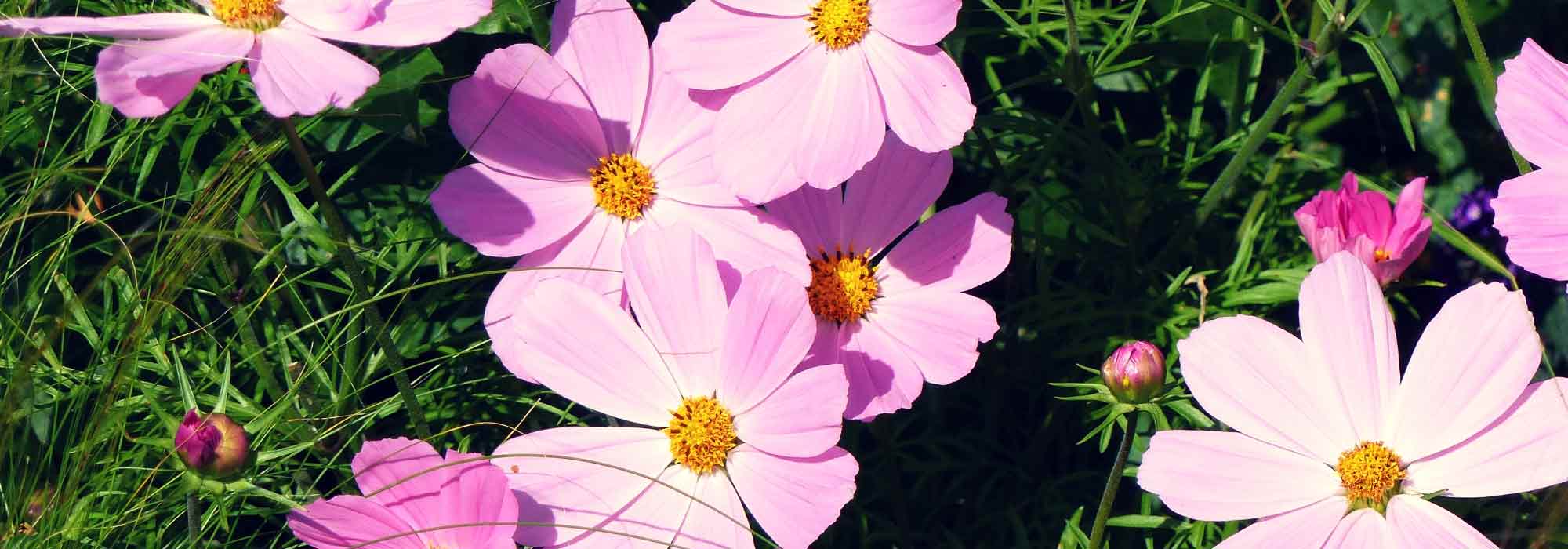
Cosmos: sowing and planting
Contents
Cosmos in a nutshell
- Cosmos is an annual flower, sometimes perennial, with tireless flowering from June until first frosts
- For six months it bears large pristine flowers on delicate, airy, elegant foliage
- Pure white, wine-red, pink, yellow or purple, the flowers range through tender, fresh or sunlit colours
- Very floriferous without requiring much care, ideal plant for beginners, almost impossible to get wrong!
- It is as spectacular in sunny borders as in bouquets or in pots!
A word from our expert
In the daisy family (Asteraceae), the Cosmos are undoubtedly among the easiest annuals to grow! From June, these timelessly charming Cosmos rise up and only disappear at first frosts.
Under their simple, naïve appearance, cosmos flowers signify innocence!
This plant, with feathery foliage and single or double edible flowers in shades from white to wine-red, exists in a wide range of sizes and genera.
From Cosmos Bipinnatus to Cosmos atrosanguineum or “chocolate cosmos” whose flowers give off a cocoa scent, all are very floriferous and provide an abundant flowering for six months, into autumn.
With their graceful silhouette, they are perfect for quickly brightening a slightly empty corner of the garden and for filling spaces between still-sparse perennials.
Their somewhat old-fashioned or sunny colours suit particularly well romantic gardens, English gardens, wildflower meadow or to liven up a border that’s a bit too restrained.
This annual is easy to grow across France, even in dry soil.
Discover our unique collection of annual Cosmos plug plants and Cosmos seeds, this graceful flower will make a big impact in sunny borders as much as in bouquets!
Description and botany
Botanical data
- Latin name Cosmos
- Family Asteraceae
- Common name Cosmos
- Flowering May–June to November
- Height 0.30 to 1.80 m
- Sun exposure Sun, partial shade
- Soil type All, well-drained
- Hardiness frost-tender
The Cosmos is an annual or perennial plant native to meadows and thickets of southern United States and Mexico belonging to family Asteraceae like daisies, dahlias and asters.
The genus comprises about 25 species, but only three are grown in our gardens. Often regarded as an annual, Cosmos is in fact a frost‑tender perennial plant. Cosmos are classed in two main groups: the Cosmos bipinnatus or bipinnate cosmos, the most widespread with large single white, pink or red flowers, and the Cosmos sulphureus with smaller flowers in warm yellow‑orange tones.
Both groups have produced numerous cultivars such as ‘Picotée’ or ‘Cosmic Jaune’ and interesting strains like ‘Sonata’, a collection of dwarf cultivars with very compact young plant growth, ‘Sensation’ which groups giant cultivars, ‘Lady bird’ with feathery‑foliage cultivars, and the ‘Double Click’ group that brings together varieties with double or semi‑double flowers.
Occasionally encountered is Cosmos atrosanguineum or the “chocolate cosmos”, which is a tuberous perennial species whose flowers give off a
Cosmos quickly form a dense clump, erect to spreading with a very bushy, ramified habit. Depending on variety, height ranges from 30 cm for semi‑dwarf cosmos up to 1.80 m for giant forms.
Sturdy stems bear an elegant, finely divided foliage as delicate as fern, dill or fennel. Deciduous leaves measuring 7 to 30 cm are arranged in opposite pairs, simple, pinnatisect in Cosmos bipinnatus and Sulphureus or pinnate in Cosmos atrosanguineus.
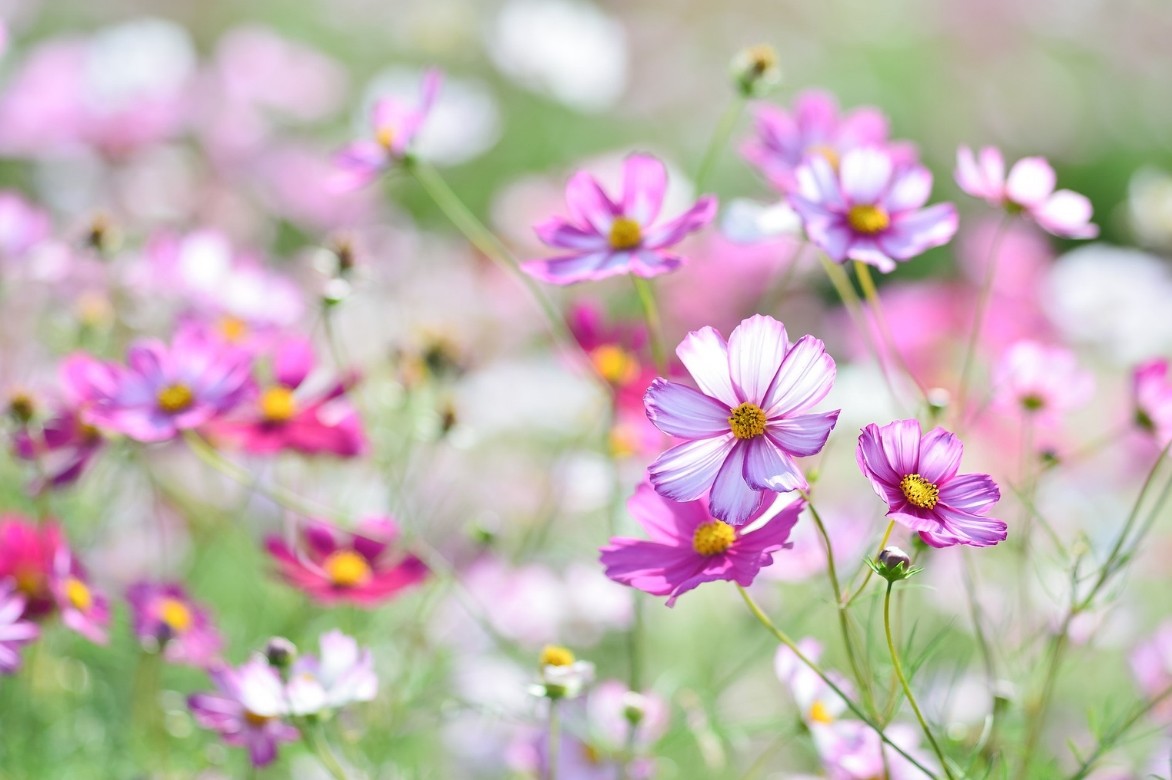
Foliage ranges from pale to dark green and is often slightly scented when crushed. Cultivars of the ‘Lady bird’ series display feathery foliage.
From May to November, Cosmos generously produce delicate, wonderfully simple flowers that seem to float above an airy clump of foliage. In Greek, “Kosmos” means ornament, a nod to these timelessly graceful flowers.
Set in numbers at the tips of fine, well‑branched stems, the large solitary heads measuring 2 to 9 cm in diameter, with a broad cup shape, appear. They are composed of round or ovate petals delicately fringed with notches at the tip, gathered into a single, double or semi‑double corolla and radiating around a golden‑yellow or dark brown centre. Diaphanous petals with a velvety texture are slightly plicate.
Shape of the ligulate florets varies with cultivar, producing flowers ranging from simple to increasingly fanciful forms.
Some varieties feature very double, pompom‑like flowers, while others, such as the ‘Sea shell’ cosmos, display surprising blooms made up of tubular, undulate petals that lend an extravagant appearance to the flower.
Cosmos flowers come in romantic pastel tones or bright, sunny colours: pure white, pale yellow, pink, purple or crimson in Cosmos bipinnatus and its cultivars, and from lemon yellow to scarlet red including orange in Cosmos sulphureus and its cultivars.

Cosmos vary in form and colour: Cosmos bipinnatus ‘Rose Bonbon’, Cosmos bipinnatus ‘Picotee’ (©Horticolor), Cosmos atrosanguineus ‘Chocamoca’, Cosmos bipinnatus ‘Xanthos’, Cosmos sulphureus ‘Cosmic Orange’
These corollas are often bicoloured, regularly striped and edged in a darker hue.
Although Cosmos flowers are usually unscented, those of Cosmos atrosanguineus give off gourmand aromas of chocolate and vanilla.
Their flowers make chic, fresh or country‑style bouquets and hold up very well in a vase.
Another attraction is that Cosmos flowers are edible, with a subtle floral flavour ideal for garnishing salads, decorating cakes and also for sorbets and ice creams in summer!
This flowering display, exceptionally generous and particularly melliferous, attracts many insects and butterflies throughout summer.
This annual is tireless, it flowers for more than six months of the year: the light, poetic display continues until first frosts.
In former times, flowers of Cosmos sulphureus were used to produce a pigment for dyeing textiles yellow‑orange.
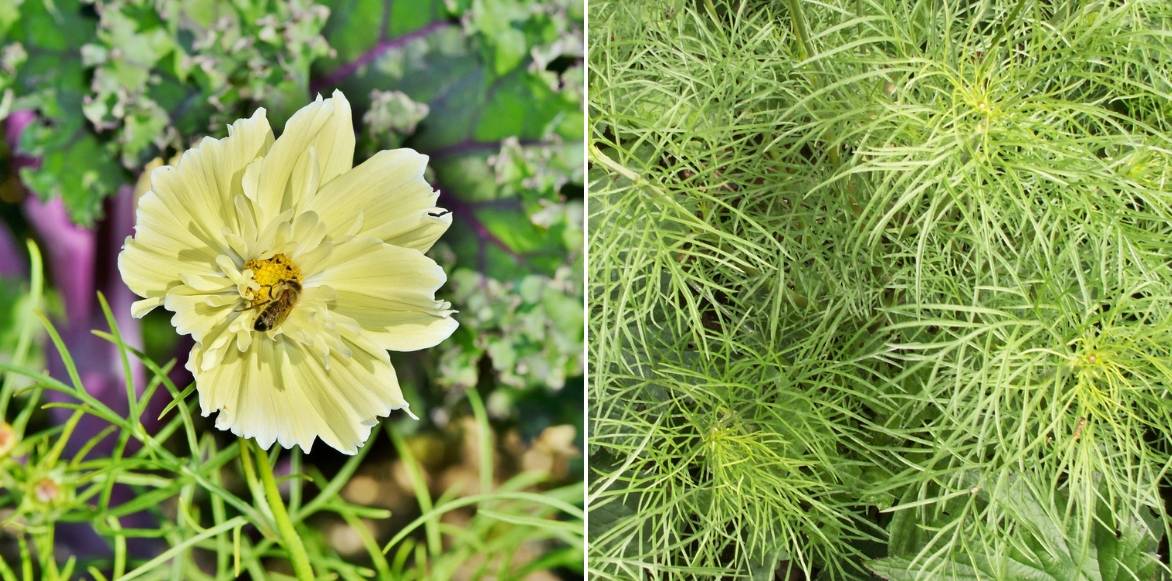
Flowers are much appreciated by pollinators and foliage is particularly decorative
Flowers are followed by the formation of blackish, bristly fruits, much appreciated by birds. Cosmos seeds self‑seed easily from one year to the next in soil.
Cosmos is a non‑hardy perennial plant that is grown as an annual in all our regions. It is planted or sown in sun in any good garden soil, not too rich, even poor and dry.
The Cosmos is perfect for bringing colour and cheer to the garden throughout the season with minimal maintenance. Indispensable in country‑style schemes, in natural gardens and romantic gardens, it adds lightness and poetry.
It fits everywhere in summer perennial beds, to flower vegetable gardens or a large, slightly wild meadow, dry rockeries, borders and even in window boxes or pots on terrace or balcony.
Main species and varieties
If genus includes 25 species of annuals and perennials, only three occur in our gardens; Cosmos bipinnatus or bipinnate cosmos with pink, white or crimson flowers that can reach up to 1.8 m, Cosmos sulphureus, more delicate in appearance with mainly orange flowers, and Cosmos atrosanguineum, the “Chocolate Cosmos” with a cocoa scent, a perennial that is not very hardy.
The first two, grown as annuals, have produced many interesting series such as the ‘Sensation’ series grouping giant cosmos, white or pink, reaching up to 1 m tall, and the ‘Sonata’ series, whose cultivars with a semi-dwarf habit do not exceed 60 cm and are ideal for container growing.
Flowers, single or double depending on cultivar, come in every colour, from pastels to deep crimson reds or the brightest oranges, from pure tones to subtle bicolours.
In plug plants or seeds, choose from our unique annual Cosmos collection.
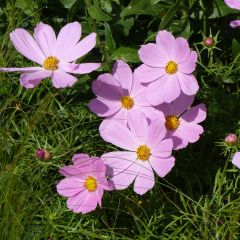
Cosmos bipinnatus Sonata Light Pink
- Flowering time July to November
- Height at maturity 50 cm
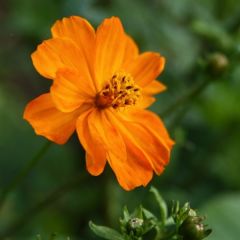
Cosmos sulphureus Mandarin
- Flowering time July to December
- Height at maturity 30 cm

Cosmos Sensation Purity Seeds - Cosmos bipinnatus
- Flowering time July to November
- Height at maturity 1,20 m
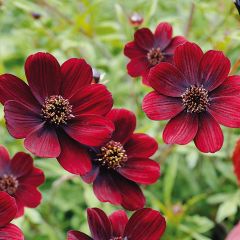
Cosmos atrosanguineus Chocamocha
- Flowering time July to November
- Height at maturity 40 cm

Cosmos bipinnatus Cosmos Double Click Mixed
- Flowering time July to November
- Height at maturity 95 cm

Cosmos Sonata Carmin - Garden Cosmos
- Flowering time July to November
- Height at maturity 60 cm

Cosmos sulphureus Polidor - Sulfur Cosmos
- Flowering time July to November
- Height at maturity 75 cm

Cosmos Velouette Seeds - Cosmos bipinnatus
- Flowering time July to November
- Height at maturity 85 cm

Cosmos Sensation Picotee - Cosmos bipinnatus seeds
- Flowering time August to October
- Height at maturity 90 cm
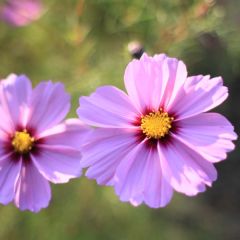
Cosmos Sensation Radiance - Cosmos bipinnatus seeds
- Flowering time August to October
- Height at maturity 90 cm
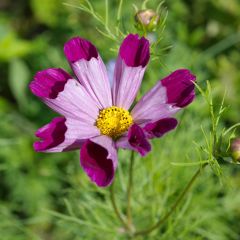
Cosmos Pied Piper Red Seeds - Cosmos bipinnatus
- Flowering time July to November
- Height at maturity 75 cm

Cosmos Xanthos Seeds - Cosmos bipinnatus
- Flowering time July to November
- Height at maturity 60 cm
Discover other Cosmos seeds
View all →
Available in 1 sizes

Available in 1 sizes
Available in 1 sizes
Available in 0 sizes
Available in 1 sizes
Available in 1 sizes
Available in 1 sizes
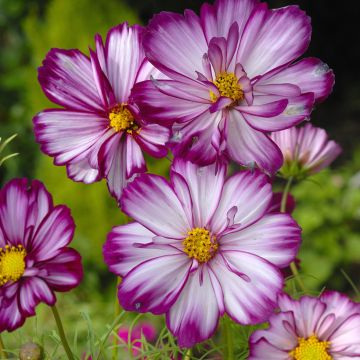
Available in 1 sizes
Available in 1 sizes

Available in 1 sizes
When and how to plant cosmos
Where to plant Cosmos?
From South American origins, Cosmos has retained a strong frost-tenderness. It is a frost-sensitive perennial that only withstands light frosts. Cosmos dies at first frosts. For this reason in our climates it is often grown as an annual in the garden.
One exception: Chocolate Cosmos is treated like a Dahlia: lift the tubercules before frosts and store in a cool place.
Cosmos’s fragility is only apparent! This non-hardy annual is very easy to grow across France and is drought-tolerant once established. For good flowering, Cosmos needs a sunny exposure.
Undemanding as to soil, it is an all-rounder that will suit any well-drained soil that stays cool during summer, showing a preference for poor, sandy or even stony soils. It will even flower in dry soil and will self-seed easily without becoming invasive.
Cosmos atrosanguineus prefers lighter, more humus-bearing and cool soil.
The tallest varieties, with their delicate silhouettes, may buckle in bad weather. It is better to shelter them from prevailing winds or stake them if site is too windy. Grouping plants can help them support each other. Smaller Cosmos cope better with windy spots.
Versatile, Cosmos is perfectly suited to small gardens as well as large flowering meadows.
Cosmos’s endless flowering, from May to first frosts, makes it an excellent choice to quickly adorn very sunny beds, borders or pots and tubs. Use it generously to fill empty spaces within a still-sparse group of perennials.
Semi-dwarf varieties, particularly compact, slip easily into borders, rockeries, among perennials and even in window boxes.
The tallest cultivars form vibrant back-of-border specimens, are planted in the second or third rank of a border, dress a wall or create a small temporary informal hedge.
Cosmos also has a place in the vegetable garden and is suitable for cut flowers.
When to plant Cosmos?
Plant Cosmos in spring from April to June, once risk of frosts is definitely past and soil is warmed, for flowering from June to October.
How to plant Cosmos from plug plants?
In open ground
On receipt, pot up and keep our Cosmos annuals in plug plants under cover at a temperature above 14°C for a few weeks. As soon as risk of frosts is over, plant out in open ground or move pots into sun.
Plant approximately 4 to 9 plants per m², spaced 40 to 50 cm in all directions for tall Cosmos, 20 to 30 cm for low varieties, if a dense, abundant effect is desired.
Soil should be moderately fertile but well drained. See our advice sheet on how to plant annuals in plug plants.
- Loosen soil to the depth of a spade
- Dig a hole three times wider than the plug plant
- Place a bed of gravel under each plug in the planting hole
- Plant in slightly sandy garden soil
- Place the plug plant in centre of the hole, collar level with soil surface
- Backfill with soil
- Firm down with foot
- Water and mulch
- Stake tall varieties if necessary
In a pot
Small, compact Cosmos varieties are well suited to container culture. Plant one or two young plants per 50 cm pot depending on variety.
- Lay a good drainage layer (gravel or clay balls) in base of container
- Plant in a mix of garden soil and sand
- Place in sun
- Water very regularly for prolonged flowering
→ Learn more in our article Growing a Cosmos in a pot.
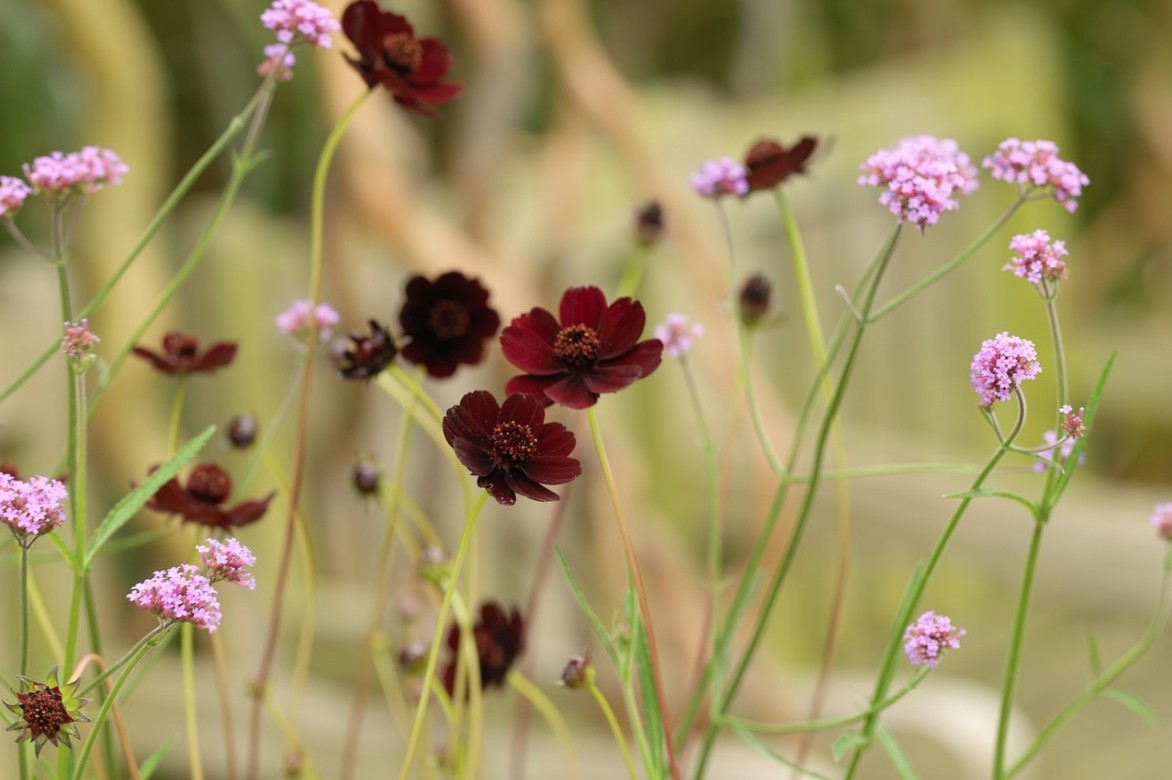
The famous Chocolate Cosmos alongside Verbena bonariensis – photo Ibulb
Read also
Planting annualsSow Cosmos seeds
Expect between 80 and 90 days from sowing to flowering for Cosmos. Cosmos seeds sown at the very start of spring continue to flower until late in season.
Sowing under cover
- In March–April, sow 1 or 2 Cosmos seeds in a seed tray at a depth of 3 mm in a light compost
- Cover seeds lightly
- Place at a temperature of 18–25 °C
- Keep compost moist until germination
- Keep only strongest seedlings and transplant into buckets
- When risk of frost has passed, harden off young plants gradually to outdoor conditions
- Plant out after frosts, spacing young plants about 30 to 45 cm apart, or in a planter
- Pinch tip of each stem to encourage branching
Sowing directly in place
Sow Cosmos seeds in May after last frosts in ordinary garden soil mixed with compost. Note seeds are quite fine: sow broadcast for a natural look. Discover all our tips to sow annual seeds directly in ground or trays.
- Dig over soil thoroughly
- Add river sand to lighten if needed
- Sow broadcast
- Cover seeds using a rake
- Water regularly until germination
- When seedlings reach 10 cm, thin to leave only one seedling every 20–45 cm depending on variety
Maintenance, pruning and care
Cosmos is a short-lived perennial, very easy to grow and undemanding. Once well established in full sun and in well-drained soil, it grows on its own.
To prolong flowering, remove faded flowers regularly. Pinch shoots; this also encourages plant to ramify and produce more flowers.
Although it tolerates short periods of drought fairly well, cosmos prefers soils that remain cool: as soon as dry weather sets in, water regularly.
You can mulch to keep soil around plant base sufficiently cool in summer.
It requires no fertiliser.
In situations too exposed to wind, tall cosmos may need staking to prevent them flopping over.
Pull up clumps at the start of winter.
In cold regions, before frosts, dig up tubercles of Cosmos atrosanguineus or “chocolate cosmos” and overwinter them in pots in a cool frost-free place.
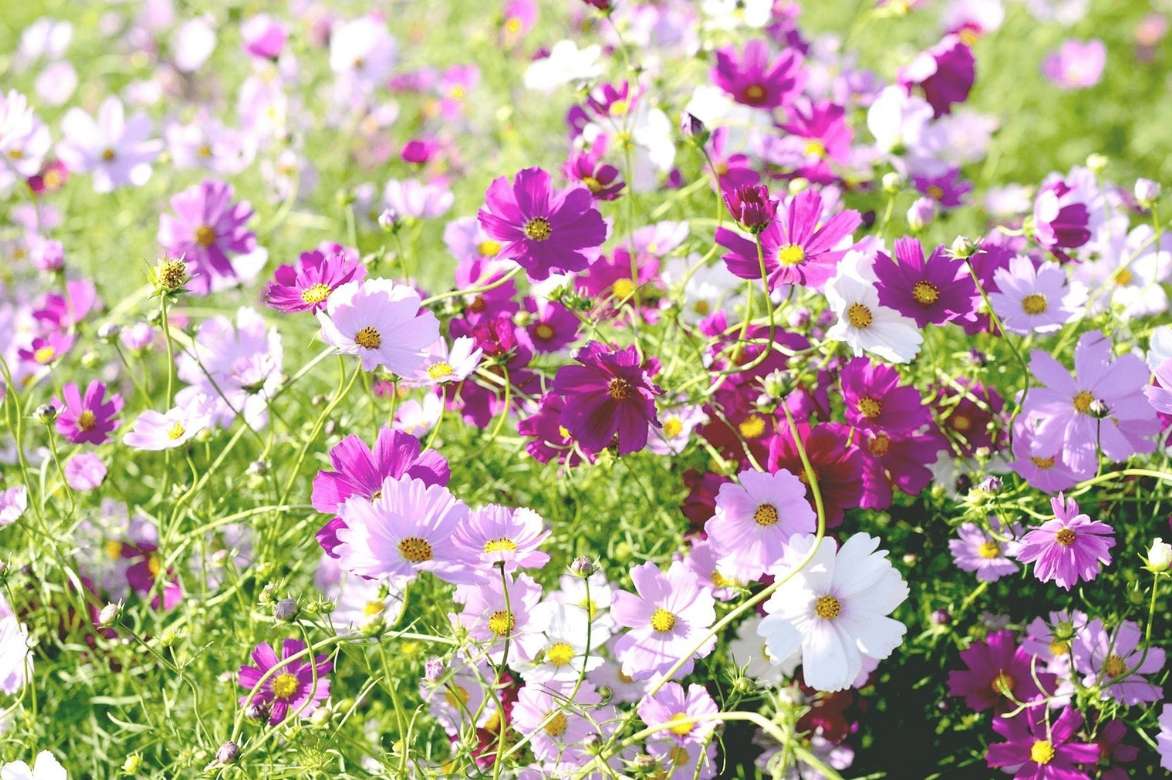
Potential diseases and pests
When seedlings emerge, protect young shoots of cosmos from slugs and snails: discover our 7 effective natural ways to control slugs and how to make a slug trap.
Young plants can be infested with aphids: spray with water containing 5% black soap.
Cosmos is also susceptible to powdery mildew. If affected, follow our advice to combat powdery mildew.
More troublesome, Cosmos can be prone to botrytis disease (grey mould) that attacks roots. Avoid soils that are too heavy or compact, which retain moisture.
Multiplication
You can harvest seeds before they disperse and follow our advice to sow cosmos seeds. Cosmos usually self-seed from year to year. These spontaneous sowings are not always true to type. ‘Cosmos chocolat’ can, however, multiply through division of tubercles in autumn.
Companion planting with cosmos
With its airy, elegant silhouette and simple flowers, Cosmos is ideal in a naturalistic garden, in cottage gardens, in country gardens to create wild, romantic-looking scenes with effortless charm. Essential in a pink garden or in a white garden.
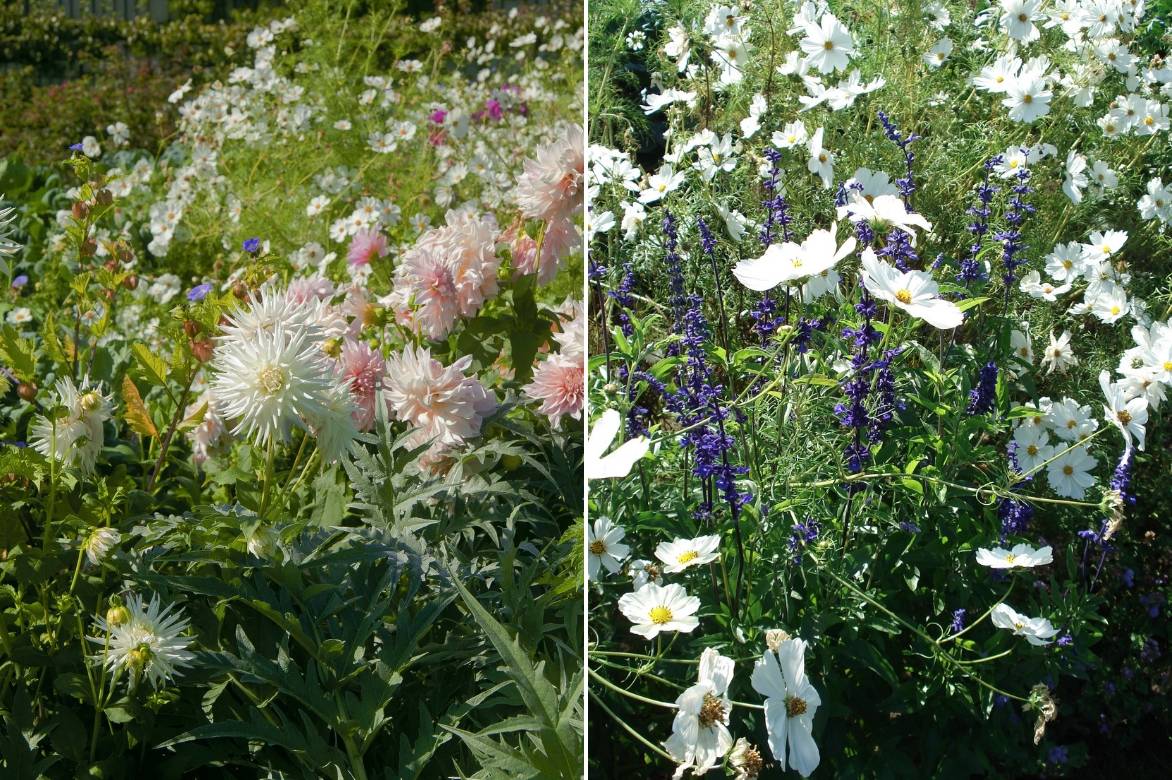
An example pairing: Cosmos Sonata white, Giant Dahlia ‘Café au Lait’, Cactus Dahlia ‘My Love’, Cynara cardunculus, Salvia farinacea ‘Victoria’
Capable of occupying a whole border on its own, Cosmos is also easy to pair with many summer flowers equally undemanding.
Cosmos adds density to borders and lightness to heavier flower displays of perennials.
To create a sunny naturalistic meadow, make a joyful mix of cosmos, achilleas (yarrow), poppies, large poppies, annual grasses such as foxtail barley, centaureas, delphiniums, or Nigellas, flaxes and scabious.
This plant brings much density to borders and lightness to the heavier flowerings of some summer perennials such as sunflowers, heleniums or cannas.

Another example pairing: Cosmos bipinnatus ‘Purity’, Salvia farinacea ‘Blue Plus’, Zinnia elegans ‘Purple Prince’, Pompon Dahlia ‘Red Fox’, White mustard (©MAP Arnaud Descat – Jardin de Saint-Jean-de-Beauregard)
Long flowering of Cosmos allows it to accompany many plants from spring to autumn, such as Alchemilla mollis, June or September roses and clumps of Perovskia.
To liven up a border that is a little too restrained and flat, pair Cosmos with tall, airy plants such as fraxinelles, Verbena bonariensis, Gauras, Crocosmias, and with other sun-loving daisies such as Echinaceas.
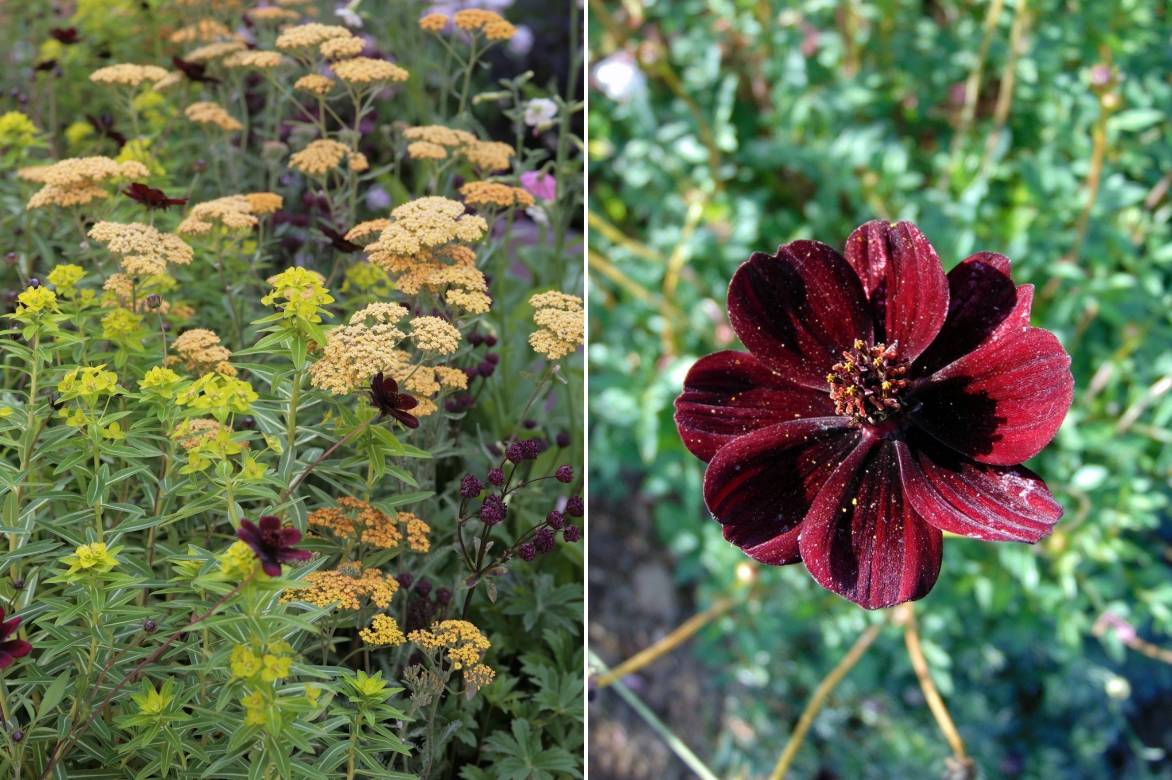
A pairing idea: Euphorbia (E. wallichii, E. martinii or your preferred species), Astrantia (‘Ruby Wedding’, ‘Ruby Star’, ‘Lars’…), Cosmos atrosanguineus, Achillea millefolium ‘Terracotta’
Play contrasts of form with grasses such as Stipa tenuifolia, Pennisetum.
In a sunny border with vivid colours, mix small cosmos with annual rudbeckias. All cosmos have a fairly bare base and are best planted behind lower-growing plants such as dianthus, hardy geraniums or salvias.
In a pink summer border, combine a few cosmos plants with dwarf dahlias, summer-flowering bushes such as buddleias and annual lavateras. Temper with a large clump of airy artemisia: flowering festival guaranteed all summer!
You can also pair it with other annuals, such as Coreopsis, Cleomes and Bidens for a colourful, high-impact display.
→ Discover 6 other great pairing ideas with Cosmos in our advice page!
Useful resources
- Cosmos are perfect plants to create in one season a romantic atmosphere in the garden
- Discover all our annual flowers
- Want ideas for which other annual plants to pair with your cosmos? Find them on our blog!
- Discover our tutorial: How to sow cosmos?
Frequently asked questions
-
Do cosmos come back?
Cosmos are frost-tender perennial plants. In our gardens, they die as soon as temperatures fall below freezing. However, spontaneous sowings are common in light, dry, well-draining soil. It is therefore perfectly possible to see cosmos reflower from one year to the next in unexpected places, often in colours that differ from the parent plant.
- Subscribe!
- Contents
.](https://www.promessedefleurs.ie/blogwp/wp-content/uploads/2018/12/cosmos-tout-savoir.jpg)

































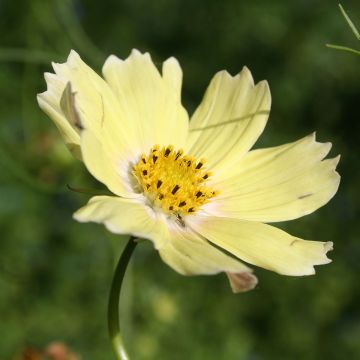



Comments